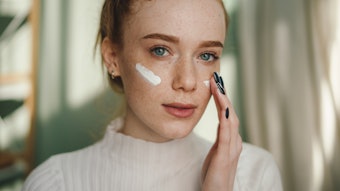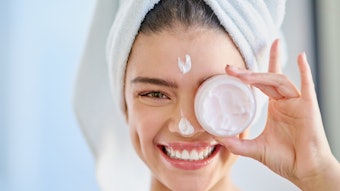One of the dominant trends in today’s dynamic skin care market is the quest for products that effectively prevent and treat aging skin. The importance of antiaging benefits is driven by demographics and the desire of most consumers to maintain a youthful appearance. The population in the leading personal care markets including the United States, Western Europe and Japan, is shifting toward older consumers as birthrates decline. At the same time, the rise in living standards in emerging markets allows aging consumers to purchase more sophisticated skin products that incorporate the latest developments in antiaging technology. The global skin care industry has responded by developing products intended to prevent premature aging, reverse specific aspects of aged skin and improve the appearance of skin.
Dimethicone – the Silicone Foundation for Skin Care
Silicones have a long history of use in skin care products, beginning in the 1950s. The first applications involved basic silicone fluids (INCI: Dimethicone). These linear polymers are liquid over a wide range of molecular weights. Dimethicones remain important for their emollient properties and their ability to improve the skin feel of many types of skin care formulations. In the late 1970s, another important class of silicones was introduced to the industry. Cyclomethicones are volatile, low-viscosity silicone fluids that act as cosmetic solvents. They are particularly suited for use with other silicones and as delivery vehicles for a variety of active ingredients.
Starting in the 1980s, the increasing popularity of silicones in skin care applications prompted silicone manufacturers to develop a variety of new materials, which led to even broader use. Many of the new silicones were derivatives of dimethicones, where specific functional groups were added to the backbone of the silicone polymer. For example, grafting hydrophilic polyethylene oxide chains to the dimethicone backbone produces non-ionic silicone surfactants that are useful as emulsifiers, foam stabilizers and wetting agents. Another family of silicones was created by introducing phenyl groups onto the silicone backbone to produce fluids with a higher refractive index and increased compatibility with cosmetic waxes. These phenyl silicones are useful for color cosmetics such as lipsticks, where the goal is to produce a high gloss coating on the lips.
One of the newest and most rapidly growing classes of silicones used in skin care applications is silicone elastomers, which are made by cross-linking dimethicone polymers to produce elastomeric solids that have properties quite different from dimethicone fluids. As the degree of cross-linking increases, the silicone network becomes more rigid. Although they are produced by a different process, silicone resins can be thought of as representing the most extreme examples of cross-linked silicone polymers. Silicone resins have a tight, three-dimensional structure that results in rigid materials that can form hard, durable films. Figure 1 illustrates variations in polydimethylsiloxane morphology based on increasing molecular weight and cross-linking.
Silicone Applications in Cosmetics
The signs of skin aging include a number of undesirable changes in its appearance, such as the development of wrinkles, loss of elasticity and uneven pigmentation. One of the most popular approaches used by skin care product manufacturers to address these problems is to develop cosmetics, which are products that temporarily improve skin appearance. Cosmetic products represent a large fraction of the skin care market because they work. They essentially provide instant gratification because consumers notice an improvement as soon as the product is applied. This is in contrast to products intended to provide a therapeutic effect, which may require 6 to12 weeks before improvement becomes apparent.
The oldest approach to enhancing skin appearance involves the application of inorganic pigments, principally iron oxides and titanium dioxide. This practice is still used in modern cosmetic products such as foundations and blushes. By choosing the proper ratio of the three forms of iron oxide (black, red, and yellow) and titanium dioxide (white), formulators can design products that cover imperfections and provide an even skin tone for virtually any skin type.
The key to achieving uniform pigment films is to deliver them in a vehicle that has good spreading properties, a function for which silicones are ideally suited. This is especially true for cyclomethicone, which helps spread pigments over the skin and then evaporates to leave the pigment behind. Cyclomethicones are available with different rates of evaporation so formulators can control the “play time,” or the time it takes for the liquid cosmetic to dry on the skin. The use of cyclomethicone and other silicone fluids became more widespread with the introduction of surface-treated pigments in the early 1980s. The treated pigment particles have a hydrophobic coating (often silicone or silane) that makes them more compatible with silicone fluids and therefore more effectively delivered from a silicone-based formulation.
Once the dried pigment film is on the skin, consumers want it to be “smudge proof” and resistant to transfer onto other surfaces. This allows application of makeup in the morning that maintains good skin appearance all day. Silicone resins such as trimethylsiloxysilicate and polymethylsilsesquioxane are film-formers that improve adhesion of pigments to the skin and transfer resistance. These resins are soluble in cyclomethicone and many other silicone fluids so they are easy to incorporate into cosmetic products. They can also be used in lipsticks to provide long-lasting color with greatly reduced transfer properties. In lip products, a high gloss film as well as attractive color is desirable. Phenyl silicones such as phenyl trimethicone are popular in this application. In addition to imparting gloss, phenyl silicones are more soluble in cosmetic waxes used in lipstick, a property that reduces the problem of syneresis, or bleeding of oil from the lipstick.
Today’s “state of the art” liquid foundations often are formulated as w/o emulsions. Unlike conventional emulsions where the oily (water-insoluble) ingredients are dispersed as droplets in water, w/o emulsions are droplets of water dispersed in the other ingredients (e.g., oils or silicones). For a foundation that incorporates silicones with hydrophobic pigments, w/s emulsions are ideal vehicles. Such formulations have pleasant aesthetics, excellent spreading characteristics and optimize the film-forming properties of silicone resins. To prepare stable w/s emulsions, special polymeric silicone emulsifiers are required. These emulsifiers are made by grafting hydrophilic groups such as polyethers onto a dimethicone backbone. Common examples are PEG/PPG-18/18 dimethicone, bis-PEG/PPG-14/14 dimethicone and cetyl PEG/PPG-10/1 dimethicone.
Approaches to Hiding Wrinkles
Applying inorganic pigments to the skin is an effective way to cover uneven skin pigmentation, but it is less effective in covering wrinkles. Wrinkles are essentially permanent indentations in the skin, and to fill them requires such a thick coating of pigment that it creates an unnatural appearance many consumers reject. In addition, most wrinkles occur in areas of the face that are stretched or compressed with changing facial expressions. These movements tend to form creases in thick pigment films. A better approach to concealing wrinkles is to apply materials with optical properties that allow them to reflect and scatter light in such a way as to reduce the visibility of wrinkles and other skin imperfections. This phenomenon is often referred to as the “soft focus” effect because it is similar to what happens when skin is photographed with a camera that is out of focus; skin features such as wrinkles are “blurred” by the effect of the treatment.
The most effective soft focus materials are various transparent particles. The transparency allows the skin color to pass through the particles, giving a more natural skin appearance. Optical effects are influenced by the size, shape, and refractive index of the particles. Spherical particles are popular because they spread well, have a pleasant feel and act as tiny lenses that bend light to create the soft focus effect. Silicone fluids offer the same benefits for delivering soft focus particles to the skin as they do for pigment particles. The refractive index of the silicone can be adjusted by choosing a dimethicone fluid or a phenyl silicone that has a higher refractive index. Spherical silicone elastomer and silicone resin particles are gaining in popularity for face care products. These are useful for soft focus applications because they have a different refractive index than organic cosmetic oils. Light scattering typically increases when the oils and the particles in the film have different refractive indexes. Apart from their aesthetic and optical properties, silicone elastomer particles offer the added benefit of absorbing sebum.
Prevention of Skin Aging
Many skin care products make claims for the prevention of skin aging by protecting the skin against the damaging effects of pollution, cigarette smoke, free radicals and other environmental insults. These claims have some scientific basis, but by far the most important factor in skin aging is exposure to the ultraviolet radiation in sunlight. Countless studies have shown that ultraviolet radiation causes cumulative skin damage that leads to loss of elasticity, uneven pigmentation and other signs of aged skin. The most effective prevention is regular use of sunscreen, which protects the skin against exposure to ultraviolet radiation.
Recognition of this fact has led to rapid expansion of products that contain sunscreen ingredients, particularly for use on the face and other areas of the body that are exposed to the sun on a daily basis. These active ingredients fall into two broad categories: organic and inorganic. Organic sunscreens are usually oily liquids that are added to a formulation in concentrations ranging from 3%-15%. Inorganic sunscreens consist of particles of titanium dioxide or zinc oxide that are used alone or in combination with organic sunscreens. When used alone, inorganic sunscreen concentrations range from about 10% to as high as 25%. When used to supplement the protection form organic sunscreens, inorganic sunscreens are typically included at 2-8%.
For both organic and inorganic sunscreens, the goal is a formulation that delivers the sunscreens in a uniform film to maximize protection against ultraviolet radiation. The film should remain uniform over time and help keep the sunscreens in place so they are not removed when the skin is brushed against other surfaces. For sunscreen products intended for use at the beach or during exercise, the sunscreen film must also be resistant to wash-off.
Silicone fluids are widely used in sunscreen formulations because of their ability to reduce the oily and sticky skin feel associated with high levels of organic sunscreen oils. Silicone fluids with phenyl groups have better solubility in sunscreen oils and this can increase the effectiveness of the sunscreen, presumably by producing a more uniform film on the skin. Silicone waxes in which long-chain alkyl groups have been grafted onto the silicone backbone have been shown to increase the protective effect of sunscreens. These silicone waxes are solids that affect the rheology of the formulation; they increase the viscosity of the sunscreen film on the skin so that it has a greater tendency to stay in place.
A number of different polymers are used to increase the water resistance of sunscreen formulations. Many are acrylate polymers and silicone manufacturers have produced hybrid silicone-acrylate copolymers that offer the benefits of both. Other silicone film-formers such as silicone resins have been shown to increase the water resistance of sunscreens.
Inorganic sunscreens are gaining in popularity because they can offer more effective protection against ultraviolet radiation, but these sunscreen actives also can present formulation challenges. Both titanium dioxide and zinc oxide are fine powders that are difficult to handle in production due to dusting and concerns about inhalation by production workers. The small particle size of the powders helps reduce their white appearance on the skin, but the natural tendency of the particles to agglomerate negates the benefits of small particle size.
For these reasons, inorganic sunscreens are often sold as dispersions in a fluid. The inorganic particles are subjected to high-shear processing during dispersion production, which breaks up the agglomerated particles. Additives in the dispersion are used to prevent re-agglomeration. Cyclomethicone is a popular carrier fluid for inorganic sunscreen dispersions, particularly when the sunscreen particles have a surface treatment to make them more hydrophobic. Silicone additives such as polyether-modified dimethicones are included to prevent re-agglomeration.
Treatments for Aged Skin
Although protection from ultraviolet radiation is the most effective preventive measure for reducing skin aging, consumers with signs of aging want products that can repair the damage and return skin to a more youthful appearance. This is the realm of skin treatments that are designed to reverse the symptoms of aged skin. Such treatments represent a large part of the skin care market and utilize a variety of active ingredients. Some active ingredients have been used for many years, including tocopherol (vitamin E), retinol (vitamin A) and its derivatives, alpha-hydroxy acids (lactic acid, glycolic acid) and ingredients derived from plants. Advances in biochemistry over the past 5-10 years have produced antiaging ingredients designed to stimulate enzymes in the skin that produce structural proteins and other molecules present in younger skin. Many of these biochemical actives are peptides or peptide derivatives.
One property common to many antiaging actives is that they are fragile molecules and can lose their effectiveness via interaction with other ingredients in the formula. This problem has prompted the development of various delivery systems designed to protect the active ingredient in the formulation and make it available when the formulation is applied to the skin.
One of the simplest delivery systems that can effectively protect antiaging actives is an anhydrous formulation. This is because water and chemicals contained in the water (acids, bases, dissolved oxygen, and metal ions) are often responsible for the degradation of the actives. Although this issue is eliminated by removing water from the formulation, other problems are created. A formulation consisting entirely of oils and oil-soluble ingredients is usually perceived as greasy or oily by the consumer. Another problem is that most thickening agents used to control the consistency of the formulation must be used with water. So the challenge in an anhydrous formulation is to improve aesthetics and thicken the formulation so it is not too thin and does not separate over time.
Silicone fluids offer greatly improved aesthetics, and silicone elastomers provide thickening while further improving aesthetics. Anhydrous skin treatment products based on silicones often are sold as small gelatin capsules that provide a single application when the capsule is broken. The protective effect of a silicone elastomer delivery system for certain actives that are soluble in silicone (e.g., retinyl palmitate) has been shown for conventional water-based formulations. The active is first combined with cyclomethicone and silicone elastomers, and this mixture is emulsified into the formulation. The affinity between the active and the silicone is apparently enough to keep the active in the silicone droplets and protected from degradation.
Summary
The term silicone represents a large family of polymers that range from low viscosity fluids, to viscous gums, to cross-linked elastomers and hard resins. Their unique chemical and physical properties have made silicones important ingredients in antiaging skin care products. Although perhaps best known for their aesthetic properties, these versatile materials improve the performance of many cosmetics, sunscreens and skin treatment products. The help deliver pigments and other particles to the skin, enhance protection by sunscreens and improve the stability of antiaging ingredients.
-Michael S. Starch
Personal Care Industry Scientist, Dow Corning Corp.
On behalf of the Silicones Environmental, Health and Safety Council of North America










